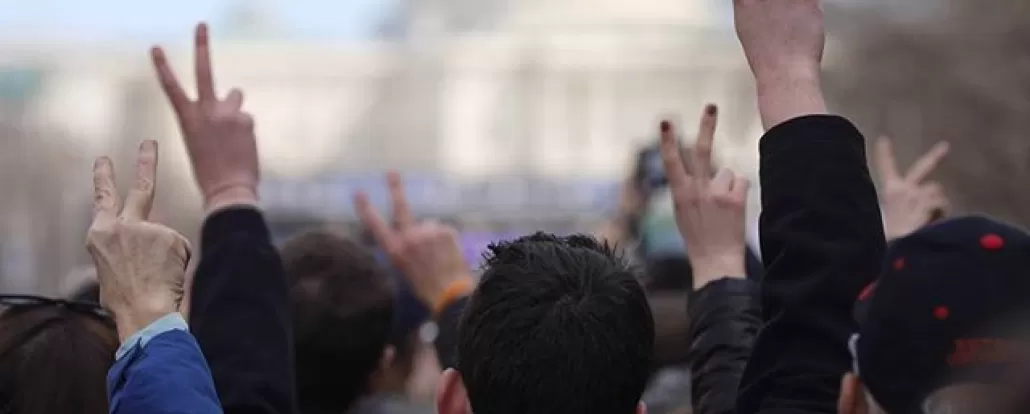The nation’s capital has hosted some of the most influential protests in the country’s history.
Washington, DC has long been a gathering place for the people to put their power of free speech to work. The right to demonstrate and assemble peacefully is one of the most essential laid out in the U.S. Constitution, so it’s fitting that the U.S. capital has often served as the scenic backdrop to important marches and protests in the country’s history, especially over the last 60 years. Below, we’ve detailed six of the most impactful demonstrations. Before you do any protesting of your own, make sure you read up on your rights for demonstrating peacefully in DC.
01
March on Washington for Jobs and Freedom
Wednesday, Aug. 28, 1963
This march, which advocated for the civil and economic rights of African Americans, was organized by A. Philip Randolph and Bayard Austin. Dr. Martin Luther King, Jr., the final speaker of the day, stood in front of the Lincoln Memorial and delivered his legendary “I Have a Dream” speech. It is estimated that 250,000 people participated, with observers projecting that roughly 75-80% were Black. Many historians cite this march as integral to the passing of the Civil Rights Act of 1964.
02
The March on Washington for Lesbian, Gay and Bi Equal Rights and Liberation
Sunday, April 25, 1993
Organizers projected that roughly one million people attended this political rally in the heart of the District. Even after the success of the Second National March on Washington for Lesbian and Gay Rights in 1987, the LGBTQ+ community still faced widespread discrimination and violence. Activist Urvashi Vaid of the National Gay and Lesbian Task Force led the push for this third march, which became the largest yet. Demands included the passage of a LGBTQ+ civil rights bill, a massive increase in funding for AIDS education, research and patient care, legislation to prevent discrimination against the LGBTQ+ community in the areas of custody, adoption, foster care and family diversity and a full inclusion of that same community in the educational system.
03
Women’s March on Washington
Saturday, Jan. 21, 2017
The main event of this worldwide protest took place in DC, with numerous other gatherings held across the country; in total, the Women’s March was the largest single-day protest in U.S. history. Attendance at the DC event was estimated at 470,000 people. The demonstrations advocated for a range of causes, including women’s rights, immigration reform, healthcare reform, LGBTQ+ rights, racial equality and freedom of religion. The event was planned as a direct response to the previous day’s inauguration of President Donald Trump. Due to the international success of this initial protest, Women’s Marches are now held annually.
04
March for Science
Saturday, April 22, 2017
DC hosted one of many marches on Earth Day in 2017. In fact, more than 600 other cities participated in this demonstration to celebrate science and raise awareness of climate change. However, the District’s protest drew the largest number of attendees, with 100,000 estimated participants. Organizers of the march sought support for evidence-based policymaking, government funding for scientific research and government acceptance of climate change and evolution.
05
March for Our Lives
Saturday, March 24, 2018
This student-led protest that called for gun control legislation drew hundreds of thousands to the nation’s capital. Organized by a passionate group of student activists from Marjory Stoneman Douglas High School in Parkland, Fl., which was the scene of a deadly shooting just over a month before, March for Our lives pushed for universal background checks on all gun sales, the closure of the gun show loophole, the restoration of the 1994 Federal Assault Weapons Ban, a ban on the sale of high-capacity magazines and bump stops and the raising of the federal age of legal gun ownership and possession from 18 to 21. More than 800 sister events took place in the U.S. and around the world.
06
George Floyd Protests
Ongoing
Nationwide protests against police brutality, spurred on by the murder of George Floyd in Minneapolis, took place throughout the summer of 2020 and continue to this day. Beginning in late-May of last year, thousands of peaceful protesters took to the streets of DC to join in the outcry that began in Minnesota. On June 1, 2020, peaceful demonstrators – many of whom were from DC – were met with violence and tear gas by federal forces between Lafayette Park and St. John’s Church. Four days later, the Black Lives Matter mural was unveiled across the plaza where protesters had gathered. The area has since been renamed Black Lives Matter Plaza in honor of Floyd and the protesters.










